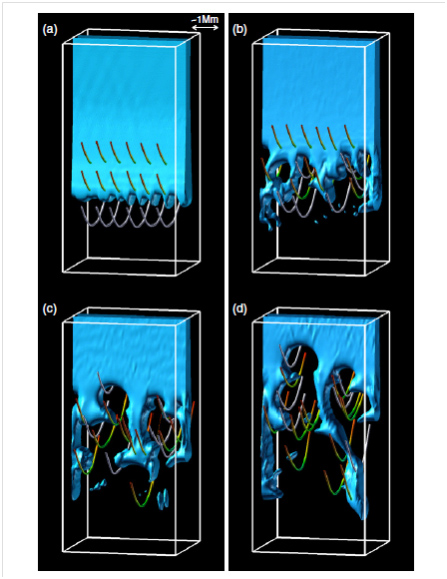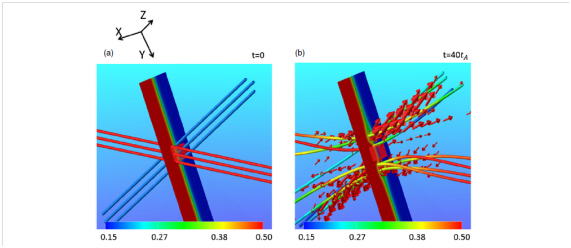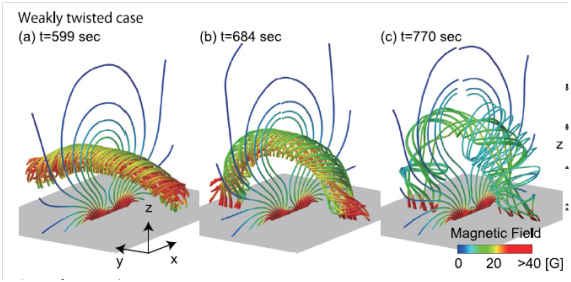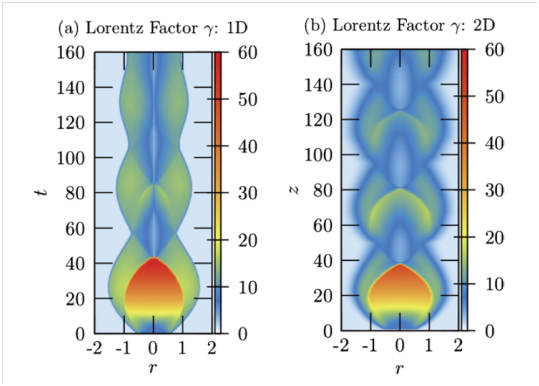Solar and Space Plasma Physics
The Sun, and the universe as a whole, is constantly showing us new and
wonderful phenomena, and we are given the task of trying to understand
what we are seeing. Due to the great complexity and nonlinearity of the
systems under observation, it is necessary perform numerical simulations
to understand what is happening. From the emergence of magnetic flux
into the solar atmosphere (e.g. Isobe et al. 2005, 2006) to eruptions
on the surface of magnetars, neutron stars with extremely strong magnetic
field (Matsumoto et al. 2011), simulations allow us to investigate the
dynamics of these systems. The great similarity in the equations used
to study these different pictures means that something learnt about
one system can often tell us something about another.
Our group works heavily on numerical simulations, and their comparison
to observations, to understand the many wonders of the universe.
References:
H. Isobe, T. Miyagoshi, K. Shibata & T. Yokoyama; Nature, Volume 434,
Issue 7032, pp. 478-481 (2005).
H. Isobe, T. Miyagoshi, K. Shibata & T. Yokoyama; Publications of the
Astronomical Society of Japan, Vol.58, No.2, pp. 423-438 (2006)
J. Matsumoto, Y. Masada, E. Asano & K. Shibata; The Astrophysical Journal,
Volume 733, Issue 1, article id. 18, 15 pp. (2011).
Exploring MHD instabilities in the Solar Atmosphere
MHD instabilities play a fundamental role in many of the observed phenomena
we see in the solar atmosphere and the stunning observations from the
Hinode satellite have provided great motivation for our group to pursue
this area of research. A prime example of this would be the Rayleigh-Taylor
plumes that are observed in quiescent prominences. These plumes are formed
at the boundary between low density bubbles and the dense prominence material
above, making them the perfect example of the magnetic Rayleigh-Taylor
instability. Through the application of 3D MHD simulations using a prominence
model, Hillier et al (2011, 2012) numerically investigate the formation and
evolution of the plumes. Figure 1 shows a 3D rendering of the simulation
results from the onset of the instability to the full nonlinear development
of the plumes.
 Figure 1: 3D MHD simulation of the magnetic Rayleigh-Taylor instability
in a prominence model.
References:
A. Hillier, H. Isobe, K. Shibata & T. Berger; The Astrophysical Journal
Letters, Volume 736, Issue 1, article id. L1, 6 pp. (2011).
A. Hillier, T. Berger, H. Isobe & K. Shibata; The Astrophysical Journal,
Volume 746, Issue 2, article id. 120, 13 pp. (2012).
Magnetic Reconnection, Jets and Flares
Magnetic reconnection is the process where the change in connectivity in
magnetic field lines results in the release of magnetic energy.
As this process can release energy on very short time scales, it is
believe to be the cause of many of the explosive energy release phenomena
in the solar atmosphere, and many other astrophysical systems as well.
Making the study of magnetic reconnection of huge importance for the
advancement of Astrophysics
Penumbral microjets, discovered by Hinode, are fast jets aligned with the
magnetic field of a sunspot penumbra. This leads to an interesting question:
How can magnetic reconnection drive jets along magnetic field lines?
Using 3D resistive MHD simulations, Nakamura et al (2012) addressed this
exact issue. Using initial conditions where a strong, angled magnetic field,
weak gas pressure region and a weak, horizontal magnetic field, strong gas
pressure region are separated by a current sheet, they were able to show
how magnetic reconnection could form gas pressure gradients along the magnetic
field, driving jets (see Figure 2). Using this model we can understand how
magnetic reconnection can create magnetic-field aligned jets.
Figure 1: 3D MHD simulation of the magnetic Rayleigh-Taylor instability
in a prominence model.
References:
A. Hillier, H. Isobe, K. Shibata & T. Berger; The Astrophysical Journal
Letters, Volume 736, Issue 1, article id. L1, 6 pp. (2011).
A. Hillier, T. Berger, H. Isobe & K. Shibata; The Astrophysical Journal,
Volume 746, Issue 2, article id. 120, 13 pp. (2012).
Magnetic Reconnection, Jets and Flares
Magnetic reconnection is the process where the change in connectivity in
magnetic field lines results in the release of magnetic energy.
As this process can release energy on very short time scales, it is
believe to be the cause of many of the explosive energy release phenomena
in the solar atmosphere, and many other astrophysical systems as well.
Making the study of magnetic reconnection of huge importance for the
advancement of Astrophysics
Penumbral microjets, discovered by Hinode, are fast jets aligned with the
magnetic field of a sunspot penumbra. This leads to an interesting question:
How can magnetic reconnection drive jets along magnetic field lines?
Using 3D resistive MHD simulations, Nakamura et al (2012) addressed this
exact issue. Using initial conditions where a strong, angled magnetic field,
weak gas pressure region and a weak, horizontal magnetic field, strong gas
pressure region are separated by a current sheet, they were able to show
how magnetic reconnection could form gas pressure gradients along the magnetic
field, driving jets (see Figure 2). Using this model we can understand how
magnetic reconnection can create magnetic-field aligned jets.
 Figure 2: 3D resistive MHD simulation of component asymmetric magnetic
reconnection. The reconnection creates gas pressure gradients along
the magnetic field, driving field-aligned jets.
Hinode telescope also found the presence of a plentitude of chromospheric
jets (Shibata et al 2007). To study these jets, and their formation through
magnetic reconnection, Takasao et al (2013) performed a numerical study
of magnetic reconnection between emerging magnetic flux and the ambient
magnetic field in a model solar atmosphere. In this simulation, it was
found that when reconnection occurred in the chromosphere the jet was driven
by MHD slow shocks directly created by the reconnection, as shown in Figure 3.
Figure 2: 3D resistive MHD simulation of component asymmetric magnetic
reconnection. The reconnection creates gas pressure gradients along
the magnetic field, driving field-aligned jets.
Hinode telescope also found the presence of a plentitude of chromospheric
jets (Shibata et al 2007). To study these jets, and their formation through
magnetic reconnection, Takasao et al (2013) performed a numerical study
of magnetic reconnection between emerging magnetic flux and the ambient
magnetic field in a model solar atmosphere. In this simulation, it was
found that when reconnection occurred in the chromosphere the jet was driven
by MHD slow shocks directly created by the reconnection, as shown in Figure 3.
 Figure 3: Formation of a chromospheric jet by a reconnection generated
slow shock in a 2D resistive MHD simulation. The jet is launched by the
slow shock passing through the transition region.
Solar flares are probably the most famous example of energy release through
magnetic reconnection. The huge energy release creates photons and particles
at incredibly high energy, making flares the most dramatic phenomena in
solar physics. MHD has been shown to be incredibly effective in describing
the physics of flares. For a full review of the physics of MHD processes
in solar flares, please see the review by Shibata & Magara (2011) on
'Solar flares: MHD processes' published in Living reviews of Solar Physics.
To greater investigate the connection between the eruption of flux rope
and the flare reconnection, Nishida et al (2013) performed 3D simulations
of destabilization of a flux rope and investigated the reconnection this
created. Figure 4 shows the flux rope as it destabilizes creating a current
sheet beneath it. Investigating evolution of this current sheet showed
the formation of multiple plasmoids, which are miniature fluxropes,
resulting in the reconnection becoming highly turbulent.
Figure 3: Formation of a chromospheric jet by a reconnection generated
slow shock in a 2D resistive MHD simulation. The jet is launched by the
slow shock passing through the transition region.
Solar flares are probably the most famous example of energy release through
magnetic reconnection. The huge energy release creates photons and particles
at incredibly high energy, making flares the most dramatic phenomena in
solar physics. MHD has been shown to be incredibly effective in describing
the physics of flares. For a full review of the physics of MHD processes
in solar flares, please see the review by Shibata & Magara (2011) on
'Solar flares: MHD processes' published in Living reviews of Solar Physics.
To greater investigate the connection between the eruption of flux rope
and the flare reconnection, Nishida et al (2013) performed 3D simulations
of destabilization of a flux rope and investigated the reconnection this
created. Figure 4 shows the flux rope as it destabilizes creating a current
sheet beneath it. Investigating evolution of this current sheet showed
the formation of multiple plasmoids, which are miniature fluxropes,
resulting in the reconnection becoming highly turbulent.
 Figure 4: 3D resistive MHD simulation of the eruption of a flux rope,
as a result of the kink instability, and the reconnection in the
current sheet created below the erupting flux rope.
References:
N. Nakamura, K. Shibata & H. Isobe; The Astrophysical Journal, Volume 761,
Issue 2, article id. 87, 10 pp. (2012).
K. Shibata et al., Science, Volume 318, Issue 5856, pp. 1591- (2007).
S. Takasao, H. Isobe & K. Shibata; Publications of the Astronomical Society
of Japan, Vol.65, No.3, Article No.62, 22 (2013).
K. Shibata & T. Magara; 'Solar Flares: Magnetohydrodynamic Processes',
Living Reviews in Solar Physics, vol. 8, no. 6 (2011).
K. Nishida, N. Nishizuka & K. Shibata; The Astrophysical Journal Letters,
Volume 775, Issue 2, article id. L39, 6 pp. (2013).
Astrophysical Plasma
From the launching of astrophysical jets through magnetic fields,
to the study of outflows and reconnection in the atmosphere of magnetars
and dynamics of molecular clouds in the galactic centre, numerical simulations
provide a very powerful tool for the investigation of dynamic Astrophysical
phenomena. Our group works on Newtonian and special relativistic simulations
of hydrodynamic and magnetohydrodynamic simulations to help our understanding
of the plasma in our Universe.
To investigate the acceleration of astrophysical jets post-launching,
Matsumoto et al (2012) performed simulations of rarefaction acceleration
(a special relativistic effect) inside the jet. Through the repeated formation
of shocks, the interaction of shocks with the contact discontinuity at the
edge of the jet and the formation of rarefaction waves as a result of this
interaction, the jet can undergo multiple accelerations from the rarefaction
waves. Figure 5 shows the evolution of the jet in both 1D and 2D simulations.
Though the 1D simulations are simpler than the 2D simulations, the similarity
between them is remarkable.
Figure 4: 3D resistive MHD simulation of the eruption of a flux rope,
as a result of the kink instability, and the reconnection in the
current sheet created below the erupting flux rope.
References:
N. Nakamura, K. Shibata & H. Isobe; The Astrophysical Journal, Volume 761,
Issue 2, article id. 87, 10 pp. (2012).
K. Shibata et al., Science, Volume 318, Issue 5856, pp. 1591- (2007).
S. Takasao, H. Isobe & K. Shibata; Publications of the Astronomical Society
of Japan, Vol.65, No.3, Article No.62, 22 (2013).
K. Shibata & T. Magara; 'Solar Flares: Magnetohydrodynamic Processes',
Living Reviews in Solar Physics, vol. 8, no. 6 (2011).
K. Nishida, N. Nishizuka & K. Shibata; The Astrophysical Journal Letters,
Volume 775, Issue 2, article id. L39, 6 pp. (2013).
Astrophysical Plasma
From the launching of astrophysical jets through magnetic fields,
to the study of outflows and reconnection in the atmosphere of magnetars
and dynamics of molecular clouds in the galactic centre, numerical simulations
provide a very powerful tool for the investigation of dynamic Astrophysical
phenomena. Our group works on Newtonian and special relativistic simulations
of hydrodynamic and magnetohydrodynamic simulations to help our understanding
of the plasma in our Universe.
To investigate the acceleration of astrophysical jets post-launching,
Matsumoto et al (2012) performed simulations of rarefaction acceleration
(a special relativistic effect) inside the jet. Through the repeated formation
of shocks, the interaction of shocks with the contact discontinuity at the
edge of the jet and the formation of rarefaction waves as a result of this
interaction, the jet can undergo multiple accelerations from the rarefaction
waves. Figure 5 shows the evolution of the jet in both 1D and 2D simulations.
Though the 1D simulations are simpler than the 2D simulations, the similarity
between them is remarkable.
 Figure 5: 1D and 2D simulations of jet evolution showing the increase
in Lorentz factor as a result of the rarefaction acceleration of the jet.
It is remarkable how similar the results are from the 1D and 2D simulations.
References:
J. Matsumoto, Y. Masada & K. Shibata; The Astrophysical Journal, Volume 751,
Issue 2, article id. 140, 18 pp. (2012).
Figure 5: 1D and 2D simulations of jet evolution showing the increase
in Lorentz factor as a result of the rarefaction acceleration of the jet.
It is remarkable how similar the results are from the 1D and 2D simulations.
References:
J. Matsumoto, Y. Masada & K. Shibata; The Astrophysical Journal, Volume 751,
Issue 2, article id. 140, 18 pp. (2012).
|

